
 |
Recent Books by Forum Members |

 |
 |
|
|
|||||||
 |
|
|
Thread Tools | Display Modes |
|
#271
|
||||
|
||||
|
Chris, I have given several examples where American machine gunners have shown sound tactical abilities, which match, if not out class those used by their British counterparts.
I look forward to your examples which prove your view (along with others you mention) that they were leaders in developing their use and tactics in combat. |
|
#272
|
|||
|
|||
|
Hello Brent,
You quote two examples of Americans using the Gatling gun that post date the British use of it, with no comparison whatsoever of whether the tactics employed were better than the British or not. They are simply quotes of what Americans did in two instances. Indeed both of your examples (1885 and 1898) occurred after the British had employed the Gatling on active service, and the example from the Spanish American War (1898) was 9 years after the British abandoned the Gatling for the far more effective Maxim gun. The fact the Americans didn't adopt the Maxim until 1904, seems to me that they actually lacked an appreciation of the machine gun. It may be their experience in the Spanish American War compelled them to adopt the Maxim, albeit 5 years after the war. Nor was the Gatling the truly effective machine gun you make it out to be. In technical terms it is actually a mechanical gun, it was known to be unreliable, and it didn't make the mitrailleuse obsolescent as you claim. Both guns operated on the same principle, and the reason the French gave up the mitrailleuse was because of its perceived disappointing performance on being easily silenced by the German artillery, rather than being obsolescent. Other nations also abandoned the Gatling as a field army weapon, relegating it to fortress armament. Others completely eschewed the Gatling because of its unreliability. I agree much later models of the Gatling were more reliable, but by then the vastly superior Maxim gun had been introduced, With due respect, you seem to be missing the point of my comment altogether, and seem intent in splitting hairs over minor issues, rather than the addressing the bigger picture that the British were among the early nations to adopt the Gatling (in the RN), and that when the first truly effective machine gun emerged, the British Army quickly acquired it - some 15 years before the Americans took it into service, some 10 years before the Germans trialed it and 19 years before the Germans adopted it in their infantry regiments. With this record I would think most would agree the British were among the leaders in adopting, using the machine gun on active service and developing tactics based on their active service experience, and certainly years ahead of either the US or German armies. I think we can agree to disagree on this issue. Clearly I haven't convinced you, and you haven't convinced me the British lagged behind the rest in adopting, employing and developing tactics for the machine gun, especially when an effective weapon in the form of the Maxim was introduced. In fact your quotes above actually reinforce my argument. Cheers Chris |
|
#273
|
|||||
|
|||||
|
Sorry for the slow reply, just too many things to do and not enough hours in the day to do it, but better late than never.
Quote:
Hmmmmm, tactics you say? It is then worth expanding on, that Brigadier General John Henry Parker or "Gatling Gun Parker" as he was better known, submitted a paper in 1897 to the Army General Staff, in which he advocated.— “The use of highly mobile machine gun detachments. These machine gun detachments would be equipped with portable machine guns capable of being dismantled and transported to the front, together with sufficient supplies of ammunition and spare parts carried in highly mobile carriages and wagons.” “Parker visualized the detachments as independent from the slow-moving artillery and ammunition trains, constantly redeploying to avoid being targeted by enemy artillery, while using terrain masking to provide cover for the men and their transport animals. As self-contained, mobile units, the machine gun detachments could be used by a commander to provide effective covering fire for the artillery trains until they could get within effective range of the enemy lines.” Parker’s 1897 submission was put to the test when he was detached “from the slow-moving artillery and ammunition train” and used his machine guns successfully in the assault and capture of San Juan Hill. “Captain Boughton, among the first of the officers to surmount the crest of San Juan Hill during the infantry assault, stated the trenches on the hilltop were already filled with dead and dying Spanish riflemen, while the open ground behind the trenchline was covered with dead and dying Spanish defenders who had been shot while attempting to flee the hail of Gatling fire.” “As an Army officer, Parker continued to expound his theories on the tactical employment of machine guns, particularly in the offense. He was a prolific writer, and contributed numerous articles and treatises to the Infantry Journal and other Army publications. Parker was promoted in rank to Captain in 1900 and was transferred to the 28th Infantry Regiment. In January 1908 he was assigned the task of developing organizational schedules and training regulations for the U.S. Army's dismounted machine gun companies” Quote:
German Mauser cartridge (Tested in Switzerland) was 612 rounds per minute. Austrian cartridge (Compressed powder) was 770 rounds per minute. United states Union Metallic Cartridge Company cartridge was 775 rounds per minute. In contrast the Model 1893 Gatling gun was capable of a maximum rate of fire of some 800–900 rounds per minute, although admittedly, 700 rounds per minute seems to be the average rate of fire for each of the 3 Gatlings during the charge up San Juan and Kettle Hills. While the US Army Command remained adamant in the matter of sticking with the M1893 Gatling, the US Navy on the other hand ordered 50 Colt-Browning M1895 machine guns (450 rounds per minute) in January 1896, with another 150 more ordered in 1898. “ The US Army, while never formally adopting the M1895, purchased 2 guns in 1902, followed by an additional purchase of 140 guns in 1904.” The same can be said of the maxim, the US Army never formally adopted it, but a number were purchased. The fact that the M1895 played a significant part in the Spanish American War, the Philippine–American War, and the Boxer Rebellion, it seems to me that the Americans did actually have an appreciation of the machine gun. Interestingly, the M1895 Colt Browning was also the weapon of choice for the Canadian contingent during the Boer war, and presumably they were supplied through Major Gat Howard’ contacts with the Colt firm, as at the outbreak of war “Howard offered to provide a battery of four machine guns at his own expense for the campaign. His generous offer was turned down.” Quote:
The Gatling gun was used by the British as defensive weapon against massed attacks involving the Matabele, the Zulu, the Bedouins, and the Mahdists. (Australia did use Gatlings as fortress armament in the 1880s, New Zealand did not) We know the Maxim evolved into the Vickers, but it is worth mentioning that the Gatling also evolved, and I think it will surprise some members that it was the Germans who took the Gatling design to the level of super weapon during WW1. http://guns.wikia.com/wiki/Fokker-Leimberger_minigun Quote:
The British were indeed among the early nations to adopt the Gatling, but the Americans were the first when it comes down to having it and using it in battle. The Germans did not trial the maxim in 1898 as you say in (Post #252) “In 1892, the German company Ludwig Loewe obtained a 7-year manufacturing license from Maxim. Manufacture of German guns commenced in 1894, and in the same year the German Navy adopted the Maxim MG in 7.92x57mm. The license expired in 1899, and at that time a newly established company, Deutshe Waffen und Munitionsfabrik (DWM) began production of the same gun for the German army as the MG99. It was similar to all other Maxim type guns made in the same period,except for the mounting, which was somewhat unusual in appearance.Unlike most mountings, which had three legs, it was a four-leggeds ledge-type mounting, known as Schlittenlafette. This weapon was slightly updated in 1901, when the bronze barrel jacket was replaced by a more economical steel one.” Quote:
I seem to have covered the Canadians under Gat Howard, and the Americans under Gatling Gun Parker. I still look forward to learning about the British counterpart you have in mind that proves the British were the leaders in developing the use and tactics of machine guns in combat? |
|
#274
|
||||
|
||||
|
Again, better late than never, the following picture is part of an ANZAC display and talk that I put on for my local scout group last week.
The German MG08 machine gun was captured by New Zealand troops during WW1. 
|
|
#275
|
||||
|
||||
|
As I am on the subject of captured machine guns, I feel it is worth mentioning that the 5th May was the 113th anniversary of when New Zealand forces captured their first machine gun, which can be seen in the following photo.
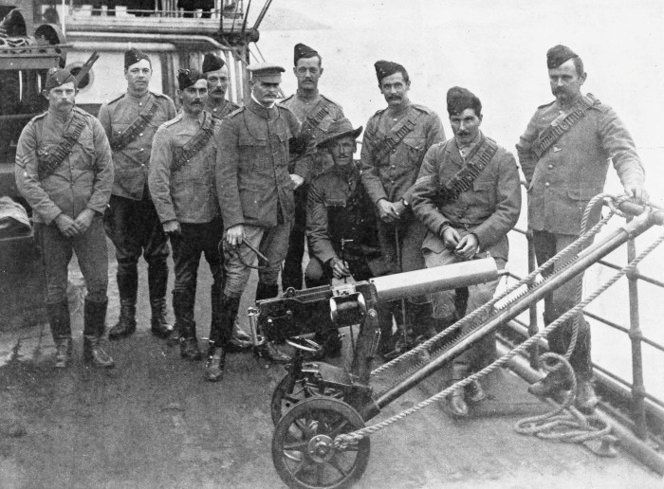 http://www.digitalnz.org/records/223...%5D=Vett+River The photo above shows Captain G. Crawshaw (in the middle wearing the SD cap and holding a whip) and soldiers of the 2nd New Zealand Contingent who helped in the capture of the Boer machine gun. The gun appears to be a .303 Model 1893 Maxim machine gun, and is most probably marked “Vickers Sons & Maxim Limited” and date stamped 1898 or 1899. (I suspect the photo was taken aboard the troop shipTongariro in Port Chalmers on the 8th May 1901) In short, the Boer maxim was captured on the 5th May 1900, when the New Zealand 2nd Contingent under the command of Major Cradock filed out of camp to occupy some kopjes they had held the previous day. Crossing the river Vet, the Australians were on the right of the New Zealanders, and the Canadians were on the left. The kopje which the New Zealanders had to take lay across an open piece of country, affording absolutely no cover and was swept by a regular murderous hail of bullets from German made Mauser rifles and British made Maxim machine guns. Undeterred, the New Zealanders crept on and crossed the river, continually moving forward by crawling with their noses buried into the ground, and as dusk began to fall, No. 2 Company made a gallant dash across the coverless plain, swarmed up the kopje. Sergeants Sidney James Henderson and Thomas Henry Overton reached the Maxim first and captured a wounded Boer artilleryman who had been working the gun. Last edited by atillathenunns; 14-05-13 at 12:16 PM. |
|
#276
|
||||
|
||||
|
The official WW1 history of the New Zealand Machine Gun Corps mentions that only one New Zealand Machine Gun was captured by enemy forces, however, it also mentions that it was quickly recovered.
The following photos show some of the machine guns that were captured by New Zealand forces. Guarding the guns captured at Messines, World War I A New Zealand soldier guards the guns captured by New Zealand troops at Messines, Belgium during World War I. There are several machine guns among the weapons. Photograph taken Bailleul, France, 14 June 1918 by Henry Armytage Sanders. http://www.digitalnz.org/records/232...2C+World+War+I  Duke of Connaught inspecting the trophies taken at Messines Date: 26 Jun 1917From: Royal New Zealand Returned and Services' Association :New Zealand official negatives, World War 1914-1918Ref: 1/2-012859-GThe Duke of Connaught, accompanied by General Godley (right), inspects the many weapons captured by New Zealand troops at the Battle of Messines. http://www.digitalnz.org/records/227...en+at+Messines 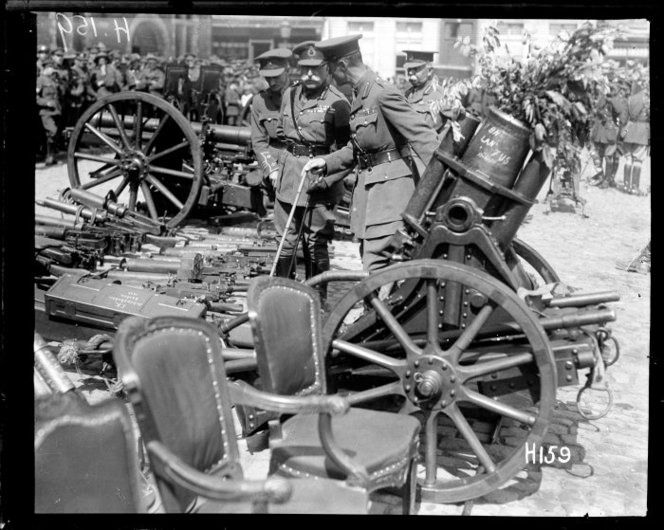 Captured German machine guns. The outward and visible sign of the result of the New Zealanders counter attack. Photograph taken 6 April 1918 by Henry Armytage Sanders Part of: Royal New Zealand Returned and Services' Association :New Zealand official negatives, World War 1914-1918 http://www.digitalnz.org/records/231...iew%5D=gallery 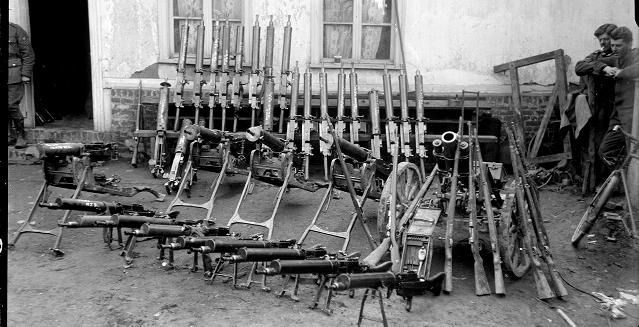
|
|
#277
|
||||
|
||||
|
In post # 133, I mentioned I am a bit of a Tank fan, and as I am on the topic of machine guns captured by New Zealand forces, it’s worth looking at these cool pictures.
The following 3 photographs were all taken by New Zealand’s WW1 official war photographer Henry Armytage Sanders, and are dated around the 7th/8th September 1918. This photo was first published in the Auckland Star newspaper, Page 9, on the 19th July 1919, and is titled.— “A German tank captured by the New Zealanders.” 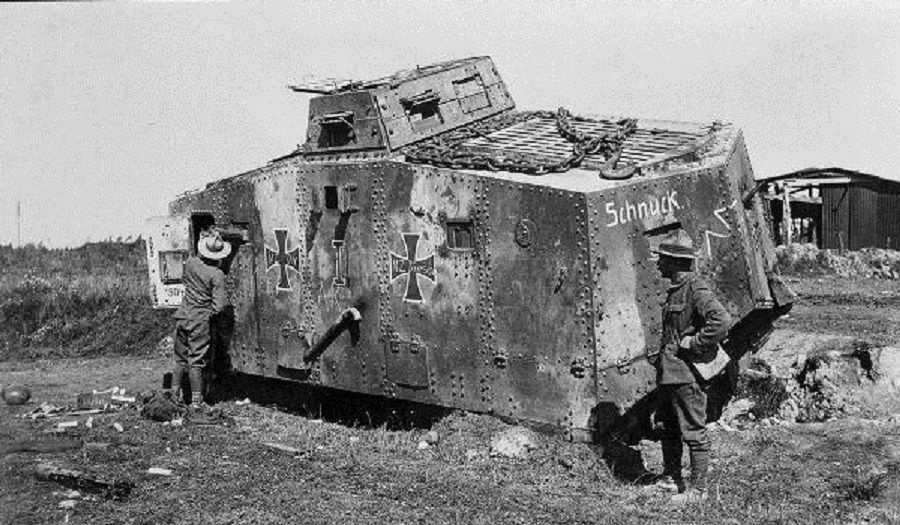 This close up view shows one of the tanks six 7.92 mm MG08 machine guns being inspected by a New Zealand soldier, it also shows the tanks number “504” on the door, and interesting to note is the “NZ Division” tagged on the German crosses. 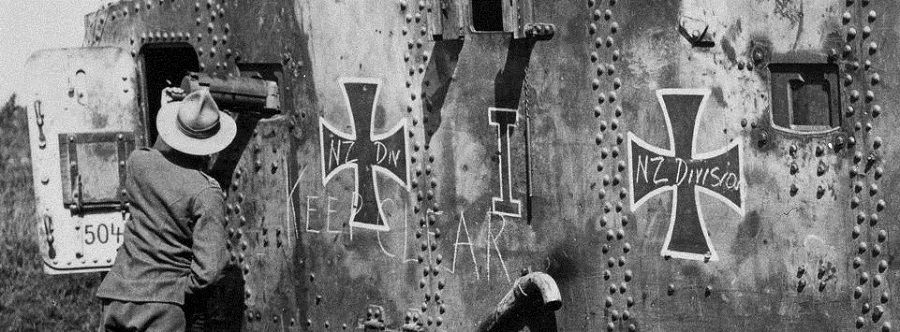 This close up view shows another of the tanks six 7.92 mm MG08 machine guns, it also shows the tanks name is “Schnuck.” 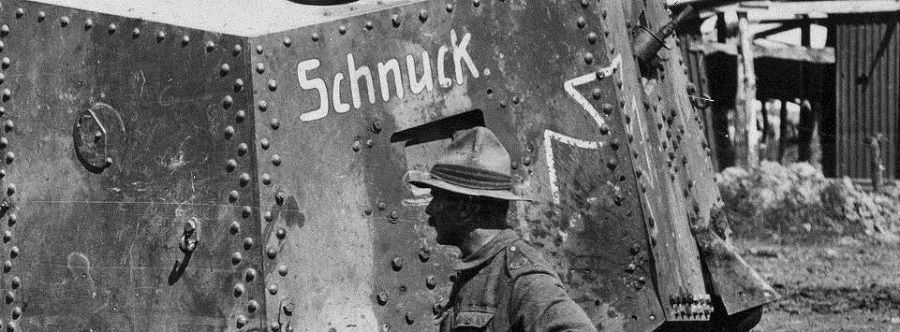
|
|
#278
|
||||
|
||||
|
The following photo shows “Schnuck” at a slightly different angle. This photo was used in the “Official History of the Otago Regiment, N.Z.E.F. in the Great War 1914-1918” by A. E. Byrne, published in 1921.
http://nzetc.victoria.ac.nz/tm/schol...OtagP042a.html It was also used in the official History of the “New Zealand Artillery in the Field, 1914-18” by J. R. Byrne, published in 1922. http://nzetc.victoria.ac.nz/tm/schol...NZArP027b.html 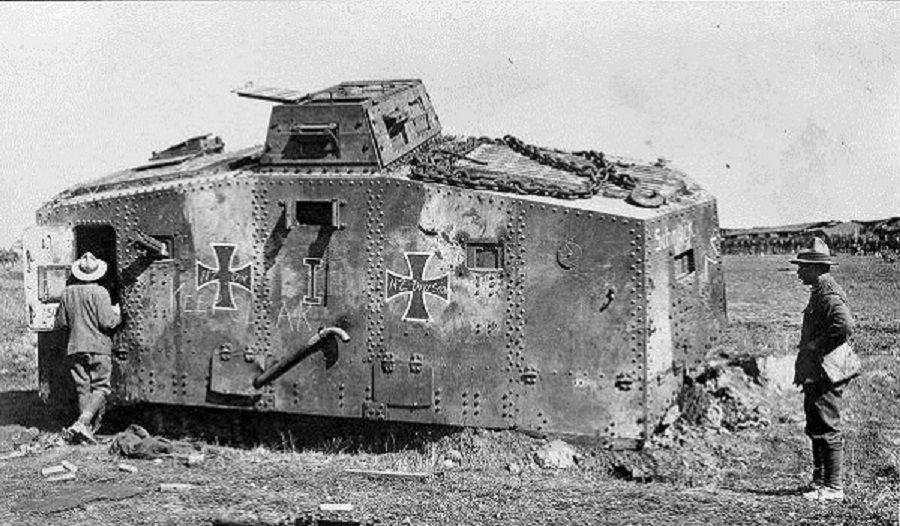 Unfortunately, as yet, I have not checked out the war diaries for the Otago’s or the NZA, so I cannot offer anything on how Schnuck was captured, however, the “Official History of the Otago Regiment” page 340, gives the following account for the period of the 28th to the 29th August 1918.— “The captures effected by the 2nd Battalion over the day totalled 200 prisoners, one enemy tank, about 60 machine guns, three trench mortars, tank rifles and other material. Our own casualties were fairly heavy, but light compared with those of the enemy.” (It appears Schnuck was captured north east of Bapaume on the outskirts of the French village of Fremicourt) The following photo was published in the “Official History of the New Zealand Rifle Brigade” by Lieut.-Col. W. S. Austin in 1924. http://nzetc.victoria.ac.nz/tm/schol...NZRiP051a.html It shows Schnuck being towed by a British tank. 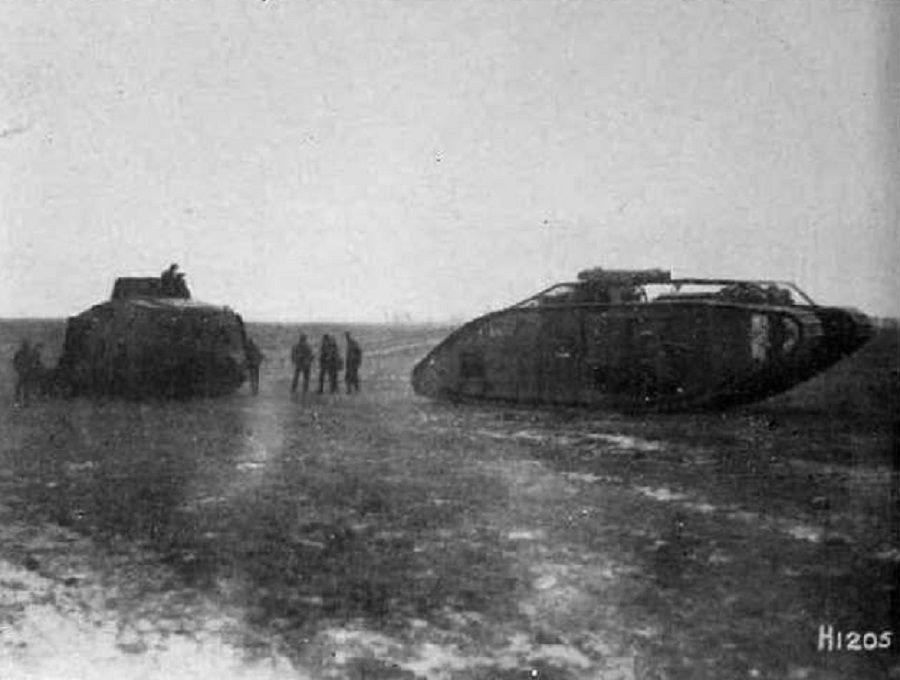 The Second Battle of Bapaume (21 August - 3 September 1918) was part of the second phase of the Battle of Amiens. Schnuck was one of two German tanks to be captured in the Fremicourt area, the second tank No. 528 named Hagen was captured by British troops. Both of the German A7V tanks were recovered and displayed in London,— “were Hagen was put on display on Horse Guards during 1919 -its fate is unknown. Schnuck went to IWM then at Crystal Palace and it and a good number of tanks and AFVs were displayed until 1920 when IWM moved to its present site -the tanks thought to be of no value were cut up in the grounds of Crystal Palace, Schnuck was even photographed being broken up and the photo reproduced in a London newspaper.” The following photo shows `Schnuck` being broken up for scrap in the early 1920’s 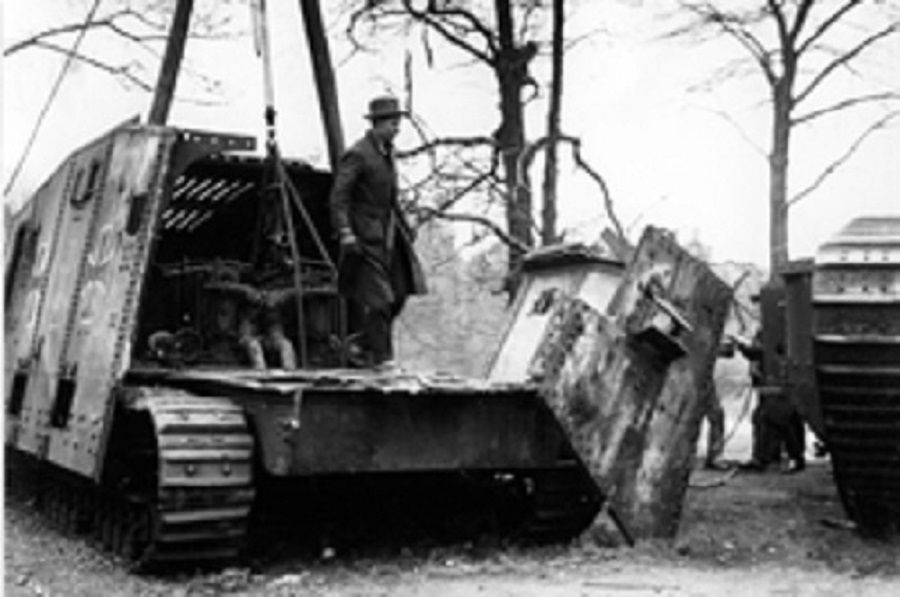
|
|
#279
|
||||
|
||||
|
“The A7V Sturmpanzerwagen known as Mephisto was immobilised in an area close to Villers-Bretonneux called Monument Wood. In July 1918 a detachment of soldiers from the 26th Battalion, mainly comprised of Queenslanders, helped recover the abandoned tank and drag it back to the allied lines. It was sent to Australia as a war trophy, arriving at Norman Wharf in June 1919 where it was towed by two Brisbane City Council steamrollers to the Queensland Museum, then located in Fortitude Valley. It remains the sole surviving A7V tank in the world”
Mephisto as it looks today 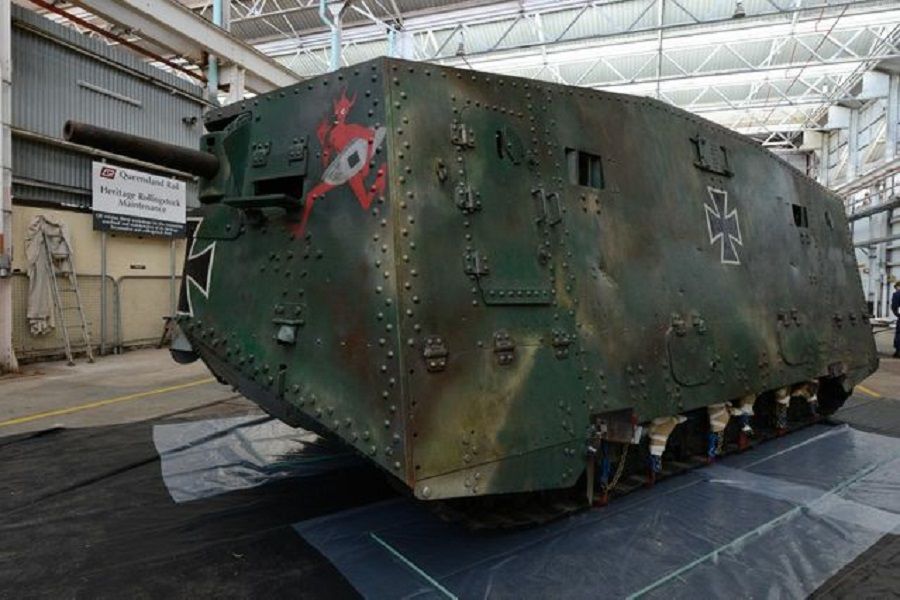 Mephisto serial number 506, as it looked after it was captured. 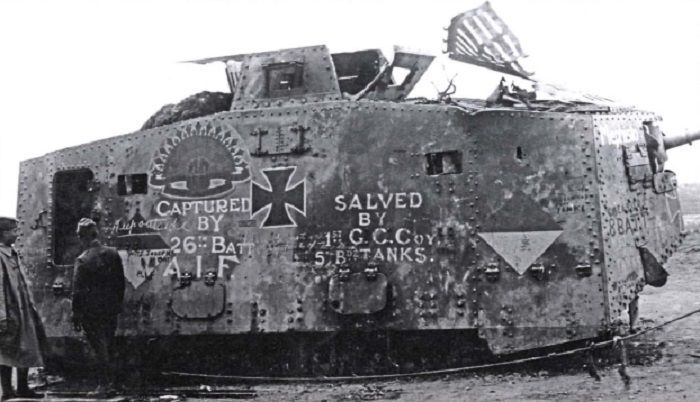 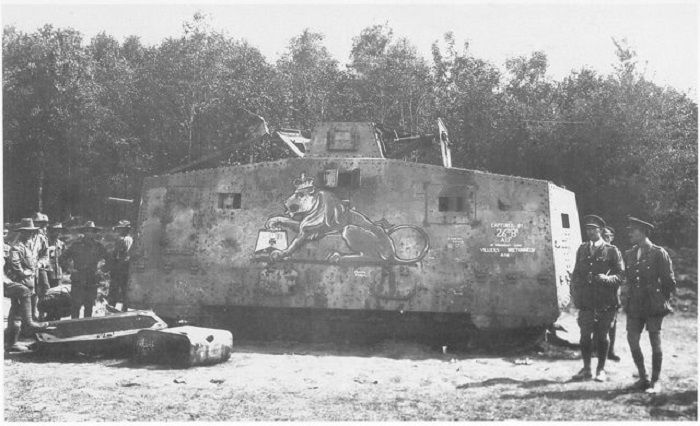
Last edited by atillathenunns; 23-05-13 at 11:22 AM. |
|
#280
|
||||
|
||||
|
“That is the gun—there is no other.”
As he placed his hand on the still smoking barrel, these were the words spoken by Kaiser Wilhelm II, German Emperor and King of Prussia in 1888. (This was almost exactly 30 years before A7V 504 “Schnuck” was captured by the New Zealanders) Ironically, it was King Edward VII (Prince of Wales at the time), while on a visit to Berlin, who spoke so enthusiastically to the Kaiser and Crown Prince about the Maxim machine gun, in consequence, elaborate preparations were made at Spandau range which was a short distance from Berlin, to trial the Maxim in front of the Kaiser and Prince of Wales, against all forms of machine guns that were available at the time. Unfortunately Sturmpanzer-Kraftwagen 504s (Schnuck) demise at the hands of 1920s Imperial War Museum bureaucrats, means the fate of its six MG08 machine guns is unknown, however, it is 99.9% probable that the 5.7-cm quick firing Maxim-Nordenfelt gun from an A7V on display at the Imperial War Museum, is the original gun from A7V 504 “Schnuck.” 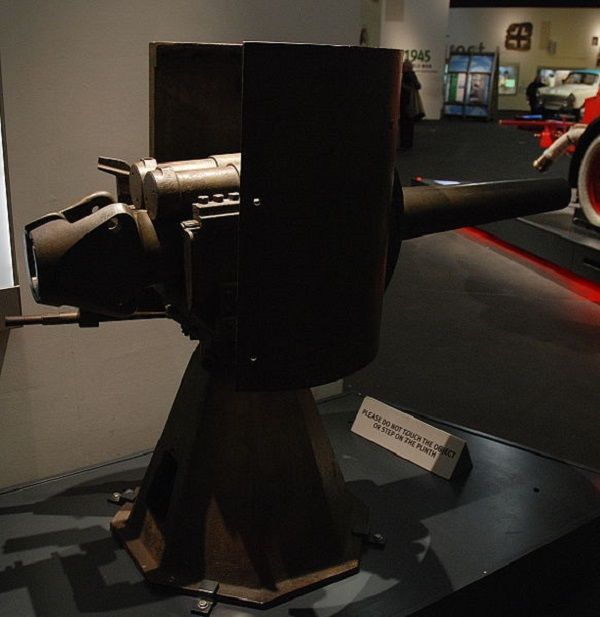 “Two full-size replicas have been constructed. One, Wotan, is in the Deutsches Panzermuseum in Munster. The second is a running replica (of Schnuck) built in 2009 by Bob Grundy of British Military Vehicles Wigan, U.K., and purchased by the Tank Museum, Bovington in November 2012.”  The “I” between the two German crosses represents that 504 “Schnuck” was part of Assault Tank Unit 1, which was formed on 20th September 1917.  You Tube footage of Schnuck replica. http://www.youtube.com/watch?v=G8-5HMmgRYo |
|
#281
|
||||
|
||||
|
The construction of Grundy's Schnuck replica at Bovington Tank Museum is said to be very similar to Peter Jackson's WW1 British Mark IV (male) tank replica named ‘Spring Chicken S13.’
The following photo (taken a few years back) shows a front view of PJs Spring Chicken S13 tank, thats me seated in the Commanders seat on the right, and my daughter is in the driver’s seat on the left. 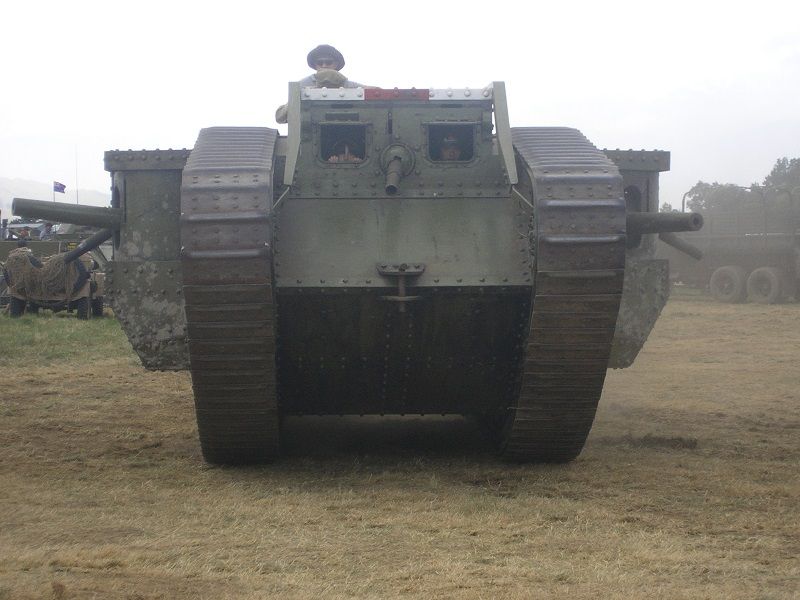 On Sunday, the 17th September 1916, just two days after British tanks were used in battle for the very first time, Sir Douglas Haig appeared in front of General Butler's offices and congratulated Colonel Ernest Dunlop Swinton and Major Albert G. Stern. General Haig said. — “We have had the greatest victory since the battle of the Marne. We have taken more prisoners and more territory, with comparatively few casualties. This is due to the Tanks. Wherever the Tanks advanced we took our objectives, and where they did not advance we failed to take our objectives.” Haig added. — “Colonel Swinton, you shall be head of the Tank Corps; Major Stem, you shall be head of the Construction of Tanks. Go back and make as many more Tanks as you can. We thank you.” Major General Sir Ernest Dunlop Swinton (Credited with influencing the development and adoption of the tank by the British during the First World War) 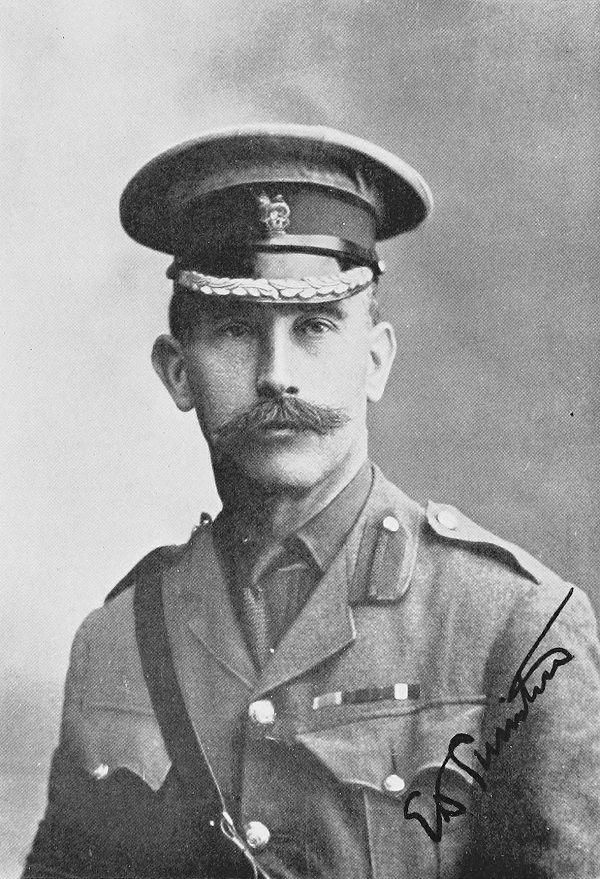 Lieutenant Colonel Ernest Dunlop Swinton was appointed to command the “Tank Detachment” in early March 1916, however due to the secrecy of the time, his promotion is gazetted on the 31 March 1916 as. — “To be temporary Colonel whilst employed on Special Duty, dated 19th March 1916.” Sadly for Colonel Swinton it was decided that command of the Tanks in France should be exercised by an officer with experience of warfare in France. Swinton suggested that Lieutenant Colonel H. J. Elles, R. E., who had been the G.H.Q.s representative for tank development and policy, should be given command. Colonel Elles was appointed as CO of the ‘Heavy Section, Machine Gun Corps,’ dated 24th September 1916. The term “tank” is said to have been taken from the similarity of the rhomboid shape of a petrol tank on a triumph motorcycle. Colonel Swinton wrote the first tank tactics called. — “Notes on the employment of tanks.” Forty-nine Mk I- Tanks were to be used on the 15th September 1916, but of these seventeen did not reach their starting point. The remaining thirty-two tanks attacked working in sub-sections of two or three tanks, and were distributed amongst a number of different infantry divisions. (Nine of the thirty-two tanks broke down through mechanical trouble, and another five got ditched.) “Most noteworthy was the feat performed by three tanks of D Company which led the assault of an English and a New Zealand Division on the strong point of Flers” The following extracts are taken from the official history of “The New Zealand Medical Service in the Great War 1914-1918” by A. D. Carbery (1924) Page 198. — http://nzetc.victoria.ac.nz/tm/schol...ody-d9-d2.html “Operation at Flers, 15th September, 1916. During the night the battle opened on our extreme left where the Fifth Army attacked and took the "Wunderwerck," a super strong point in the Hohenzollern line, so freeing the left flank of the Canadians and by 5 a.m. on the 15th the four tanks allotted to the New Zealand Division were moving out to show the way to the Infantry. The morning broke in perfect autumn weather, a slight mist lying in the valleys, the two Battalions of the Second Brigade and the Rifle Brigade were waiting the signal in their assembly trenches. At 6.30 a.m. the engagement opened, the intensive bombardment, and the creeping barrage crashed out from thousands of guns of all calibres. The two New Zealand Battalions advancing in waves passed over the Crest trench without difficulty, later suffering considerable losses from machine guns in the Highwood, attained their objective beyond the Switch trench in 30 minutes and on time, but it was not until some hours later that they had completed the clearing out of desperately fighting fragments of the Bavarian Division who still clung to portions of the broken trench line. The Rifle Brigade was now pressing on to the second and third objectives.” “Before ten o'clock, the 3rd Battalion of the N.Z.R.B. had been held up by uncut wire in front of their sector of the Flers trench and a considerable accumulation of wounded was growing in a position in the rear of the right flank of the Division; the walking wounded coming straight back in line with the Flers-Longueval road to Green Dump had reported the matter. But just at this time the 41st Division had met also with opposition and heavy shell fire in or about the village of Flers, so that most the bearers of that division were withdrawn from Green Dump and moved forward to the south east of Flers. At 10.30 a.m. tanks came to the rescue of the 3rd Battalion of the Rifle Brigade, and with their assistance our line was able to advance; the 1st and 2nd Battalions were already moving to the final objective, north of Flers—practically the whole of the second objective was now in our hands.” “By 5 p.m. the advance had ceased. Martinpuich and Coureelette had been carried by the Canadians and the Scottish Division on their right. Highwood had at last been cleared, but with grave losses to the 47th Division; the New Zealand and 41st Divisions were linked in a salient covering Flers, but Morval and Les page 200Boeufs, which were so important to the French, held out, the Guards losing heavily. Some of the objectives had been attained, not all, we had broken through three lines of defence on an average depth of one mile. The 24 tanks co-operating had met with some success. It was determined to push on with the attack the following day.” Last edited by atillathenunns; 18-06-13 at 10:27 AM. |
|
#282
|
||||
|
||||
|
Margaret Gertrude Zelle, most famously known as Mata Hari, the Indian dancer, was shot on the 15th October 1917 by the French having been condemned to death as a German spy.
One of the crimes which brought her before the Paris court-martial and eventually the firing squad was the supplying of information to the enemy that tanks would be used on the Somme. While the discussion of tanks seems way off topic from the general subject of badges worn by New Zealanders who served as machine gunners, I am unrepentant, and have decided to do a few more posts on the subject of tanks. It is however worth considering, that in 1916, when both the ‘New Zealand Machine Gun Corps’ and ‘Tank Corps’ were first formed, they both wore the crossed Vickers machine gun badges of the ‘Machine Gun Corps.’ However, I should point out that the title “Tank Corps” was not authorised until the 27th July 1917. The original 1916 designation was of course “Tank Detachment,” which was chosen so that not even the men who were building the tanks would know their purpose, and the rumour was circulated that they were to be used in connection with the watering of the army in Egypt. To maintain the secrecy, the title of ‘Tank Detachment’ was rapidly changed to “Armoured Car Section of the Motor Machine Gun Service,” but this cumbrous title was too near the truth, and in March 1916 the title was changed to the “Heavy Section Machine Gun Corps.” In November 1916, presumably to its rising strength, it was re-titled to the “Heavy Branch Machine Gun Corps.” The following extracts are from a letter (dated 12th July 1916) sent by Colonel Swinton to Brigadier-General Burnett Stuart, Director of Staff Duties, G.H.Q., France. (Sent at a time when the Army could spare no officers and men) “There is one other point in regard to the matter to which I have not made any allusion, and that is the question of the provision of personnel. So far the Heavy Section has been able to obtain a very good class of man — one quite above the average — but I rather imagine that the source of supply is to some extent exhausted.” “In the event of the development of this branch being required I would suggest that the most satisfactory way of obtaining the men would be to transfer the personnel of some existing unit which is trained in somewhat similar duties to the Heavy Section; for instance, men of the Royal Marine Artillery would, I think, be eminently suitable for duty with the Heavy Section, as they are trained in gunnery, machine-gunnery and in machinery.” In reality, the men who were the pioneers of the Heavy Section Machine Gun Corps, were drawn from many different units of the British military, but mostly they were drawn from the Motor Machine Gun units, the Army Service Corps (drivers) and the Royal Marine Artillery, but mostly, due to the four Hotchkiss machine guns on the MK1 male tank, and the five Vickers and one Hotchkiss machine guns on the MK1 female tank, a large proportion of the men were drawn from the Machine Gun Corps. “In many cases the men never actually officially transferred and fought in the tanks under their original regiments.” (The MK1 female tank also carried 4 spare Vickers machine gun barrels, 1 spare Vickers machine gun, 1 spare Hotchkiss machine gun barrel, and 33000 rounds of ammunition) One of the many subjects I am continually looking for information is — New Zealanders who served with the Tank Corps during WW1, and have so far collected over 20 names. (If you can help me with their British service records, send me a PM) One New Zealander who served with the British Tank Corps, was Lieutenant Gladstone Ward, who was the third son of twice Prime Minister Sir Joseph Ward. After serving for more than a year in the Mechanical Transport branch of the A.S.C. and at various stations in the United Kingdom, Lieutenant Ward left for Egypt in March, after a few weeks there, he was detailed for duty with the Expeditionary Force in Palestine on the transport of heavy artillery, where he was then transferred to the Tank Corps. It would be interesting to check Lieutenant Ward’s service records to see if he was transferred in time for the 'Second Battle of Gaza' on the 17th April 1917? The big question I would love to know the answer to is, did he command "HMLS Kia Ora" (mentioned in post #133) http://www.nzhistory.net.nz/media/photo/hmls-kia-ora The following picture shows a unique view of "HMLS Kia Ora" having work done to its tracks. (Track life seldom exceeded fifty miles) 
|
|
#283
|
||||
|
||||
|
Lieutenant Lester Edward Lucas Donne - British section N.Z.E.F. / Tank Corps
Lester Donne, the son of Captain Thomas Edward Donne, of the New Zealand Head-Quarters staff in London, was still only eighteen when he joined the British section of the N.Z.E.F. in England on the 21/9/14. On arrival in Egypt he was promoted to the rank of corporal on the 28/12/14, and was transferred to the Divisional Train of the NZASC as a Driver. On the 19/4/15, Corporal Lester Donne was discharged from the N.Z.E.F. under Regimental orders to join the Imperial Army, in which Donne received a commission as a Lieutenant on the 21/5/15. It appears Donne was employed in the Recruiting Department at the London War Office before he was transferred to the Tank Corps, where he served until he was badly “injured by gas and shell-shock when his ‘bus’ was struck,” just before the war ended. Staff Sergeant Murdoch McLennan (Auckland) - Tank Corps, No.301326 Murdoch McLennan, originally from Masterton, appears to have worked on passenger vessels operating between London and New Zealand prior to taking up residence in America. Murdoch McLennan was mobilised into the Tank Corps on the 20th August 1917, and was promoted to Staff Sergeant on the 16th May 1918. It appears he served in J Battalion, and after serving a total of one year and 271 days, McLennan was discharged on the 17th May 1919. Murdoch McLennan arrived in New Zealand on the 16th June 1919, and was admitted to Dunedin Hospital seven days later, due to pulmonary tuberculosis, the effects of having been badly gassed. McLennan was transferred from Dunedin to Auckland Military Hospital where he died on the 12th May 1920. Staff- Sergeant McLennan’s obituary published in the New Zealand Herald on the 13th May 1920, interestingly mentions the following.— “Staff- Sergeant McLennan, who was 37 years of age, was fighting in Mexico when war broke out, and was decorated for his services. He later enlisted in the American forces and subsequently joined the British Tank Corps. He was a member of the crew of a tank that carried the first American flag (Old Glory) across the German lines. On March 22nd 1918 the day after the great German drive commenced, the tank with the American flag attached to it, crossed ‘No Man's Land’ and attacked the German trenches. Despite heavy fire the tank returned safely to the British lines, the only damage sustained being to the flag, which contained 11 bullet holes. Staff-Sergeant McLennan subsequently returned the flag to Ukiah, California, where it was presented to him when he enlisted, and it is prized today as a valuable war souvenir.” http://www.archway.archives.govt.nz/...37&digital=yes Gunner Claude David Evans (Christchurch) - 16th Company, F Battalion, Tank Corps, No.201172 Gunner Claude Evans was taken prisoner at the battle of Cambrai in late November 1917, and for 15 months was interned at Limburg POW camp where conditions were notoriously bad.— “He received little to eat with the exception of a kind or soap made from grass and leaves, and was only seven stone in weight when released. It was only the parcels of food which he latterly received through the Dutch authorities that enabled him to exist, and he is convinced that another two or three weeks of such treatment would have killed him.” Captain George Ronald Macdonald (Christchurch) - 2nd Tank Supply Company, Tank Corps, attached 4th Tank Brigade. At the beginning of the war Captain Macdonald was with the Highland Light Infantry. It was found, however, that his eyesight was defective, and he was transferred to the Motor Transport, Army Service Corps. In the middle of 1916, while attached to the R.G.A., he was wounded by an explosion of a bomb. From 1917 he served with the Tank Corps and was mentioned in Sir Douglas Haig's despatch of November 1918. Military Cross official notification states.— “Though wounded shortly after zero hour, Captain Macdonald continued to supervise the carrying of supplies to the battalion with which he was working, in one case reconnoitring a village which was still occupied by the enemy. He refused to be medically treated until his section was withdrawn.” 2nd Lieutenant Ernest Cyril Branson (Dunedin) - Tank Corps Ernest Branson left for England with the intention of joining his late father's regiment, the 1st King's Dragoon Guards. But finding that cavalry was not being used he joined the R.H. Artillery. It appears that Ernest Branson volunteered from the inception of the tanks, but was unfortunate to have to go into hospital for a time, so I don’t think he made the 17th September 1916 tank battle. However he did receive a commission in the Tank Corps serving with them until the end of the war. Gunner Vivian Theodore Lloyd (Hokitika) - Tank Corps, No.91750 Vivian Lloyd at the age of 18, was not eligible to join the N.Z.E.F, so on the 17th December 1914, Lloyd embarked on the S.S. Turakina for England, arriving in early February 1915. On the 11th February 1915, Lloyd enlisted with the Royal Marine Artillery, serving with them for 18 months before he was transferred to the Tank Corps, in which he served with continuously without casualty until he was demobilised in January 1919. http://www.archway.archives.govt.nz/...27&digital=yes |
|
#284
|
||||
|
||||
|
“With our backs to the wall and believing in the justice of our cause, each one of us must fight on to the end.”
Order of the Day issued by Field Marshal Sir Douglas Haig, 11th April 1918. The great German ‘Spring Offensive of 1918’ (Kaiser's Battle), began on March 21st. The New Zealand Division was ordered to halt the Germans in their drive towards the important French city of Amiens. During the action on the 26-27th March 1918, the NZMGC companies played an important part in closing and holding the gap in the British line west of Amiens. It was during this period that the one and only machine gun of the New Zealand Machine Gun Corps fell into the hands of the enemy. For those interested to know more check out page 119 on the following link.— http://nzetc.victoria.ac.nz/tm/schol...dy-d1-d11.html Although the Germans did not break through, at the time, it was feared that the Germans would advance to the ports within a week, which explains Haig’s mention of “our backs to the wall.” With British forces seemingly overwhelmed by the German Spring Offensive, the Imperial Government made an appeal to the New Zealand Government to supply more men. The New Zealand Government’s response was to increase its supply of reinforcements, and in addition, offered the services of a ‘Tank Corps,’ consisting of 700 personnel to be formed from NZ reinforcements available in England. The Imperial Government accepted the services of a New Zealand Tank Corps. The Officer tasked with the formation and command of the New Zealand Tank Corps was Lieutenant Colonel George Mitchell, Service No. 8/1173. Colonel Mitchell had a long and distinguished military career. He first saw service in the South African war, where he won promotion on the field before being wounded. Embarking with the Main Body, with the rank of Major, Mitchell commanded the 4th North Otago Company at the landing on Gallipoli on April 25, 1915. During the August advance, Mitchel was badly wounded at Chunuk Bair, then evacuated to Malta and then England, and eventually was declared unlit for further service. Although lame as a result of his wounds, “Hoppy Mitchell,” as he was affectionately termed by the troops, was put in commanded of the Auckland-Wellington Reserve Battalion, and, later, all reserve battalions. Later, he proceeded to Etaples, France and reorganised the New Zealand Base Depot, and while there was the outstanding figure in quelling the serious riots which broke out amongst the British and colonial troops in the depot. Subsequently after the dispersal of the 4th Brigade, Colonel Mitchell took over as Officer Commanding the New Zealand Entrenching Group, until he relinquished that appointment, and was attached for training in Britain with the Tank Training Unit. Owing to the end of the First World War, the formation of New Zealand Tank Corps was not proceeded with. Colonel Mitchell’s appointment to the Tank Corps is dated the 29th October 1918. Sergeant William Joseph Fix (Military Medal) Service No. 4/398, NZ Field Engineers. Sergeant Fix, an Electrical Engineer from Wellington, according to his service records, joined with the Main Body in 1914, and was nominated as a member of the NZ Tank Battalion, dated the 5th October 1918. http://www.archway.archives.govt.nz/...78&digital=yes |
|
#285
|
||||
|
||||
|
Had the Germans exploited the gains made from the 21st March 1918 ‘Spring Offensive,’ or even just held the gains that they had made, the war would have continued long enough for a New Zealand Tank Corps to be formed.
Had a New Zealand Tank Corps been formed, it is likely that the majority of the “700 personnel to be formed from NZ reinforcements available in England,” would have been drawn from the New Zealand Machine Gun Section of the Specialist Company. Just out of interest, it is estimated that the British produced around 2850 tanks during WW1, the Germans on the other hand built a mere 20 A7V tanks, and one A7V-U tank which resembled a British heavy tank, but much bigger. Of the eight tank companies formed by the Germans, only three companies were equipped with the A7V tanks, the rest were equipped with captured British tanks. Interestingly, the German A7V tank went into action for the first time on the 21st March 1918, when ‘501 Gretchen’ and ‘506 Mephisto’ under the command of Hauptmann Greiff, were sent to the north of the St Quentin Canal, where they were used in a successful German counter attack against a British breakthrough. (3 other A7Vs were sent, but appear to have not reached the starting point due to mechanical failure) One month later, the first ever tank versus tank battle, took place near Villers-Bretonneux on the 24th April 1918. Three British Mk IV tanks (1 male & 2 female) of the 1st Battalion, Tank Corps, took on three German A7V tanks (561 Nixe, 525 Siegfried and 504 Schnuck). The two Mk IV female tanks armed with only machine guns were no match against the A7V tanks main gun, and after both received damage (from 561 Nixe), they turned and limped back to their own lines While 561 Nixe was focused on attacking the female tanks, the Mk IV male tank commanded by Second Lieutenant Frank Mitchell, managed to bring his left hand gun to bear on 561 Nixe. Interestingly, Mitchell’s gunner was partially blind from a gas attack the previous day, and shooting while the tank was moving over undulating ground, he was unable to land any hits on the A7V. Lieutenant Mitchell took a risk and stopped the tank to give his gunner a clean shot, his gunner didn’t hesitate and landed 3 direct hits on 561 Nixe, killing 3 and wounding 3, causing the rest of the crew to abandon their tank. Lieutenant Mitchell then turned his tank and fired on the nearest of the other two A7Vs, which both retreated Although damaged, the surviving crew of 561 Nixe managed to recover their tank and limp back to safety behind their lines. Lieutenant Frank Mitchell’s tank was abandoned after being hit by artillery fire. When Tank Meets Tank for the first time, published 15th August 1918. 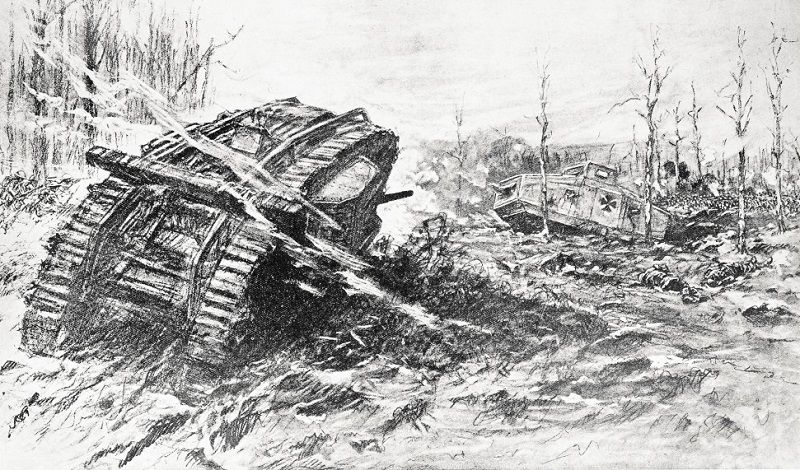 The following picture shows a better view of a captured Mark 4 female tank captured by the Canterbury regiment, which I posted in post #21 of the following thread. http://www.britishbadgeforum.com/for...t=27360&page=2 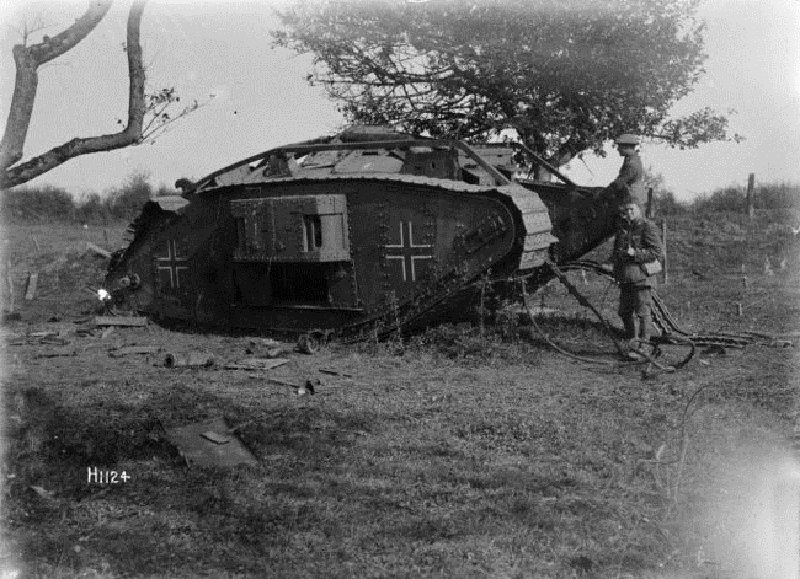
|
 |
|
|
 |